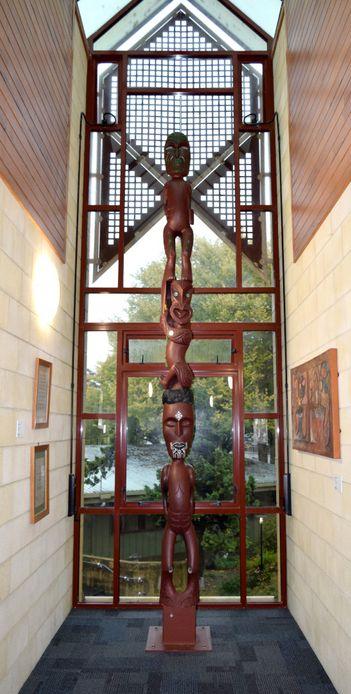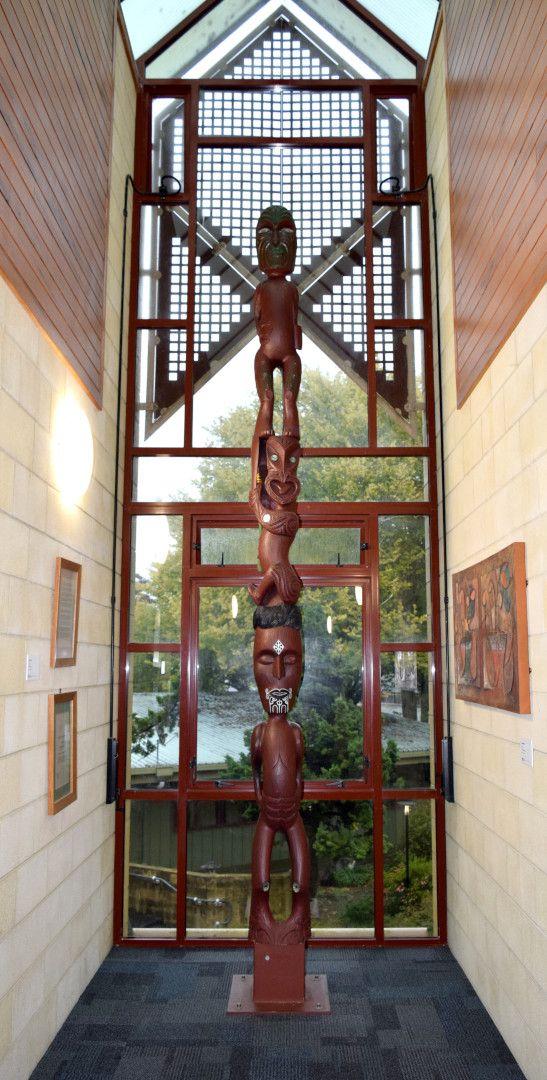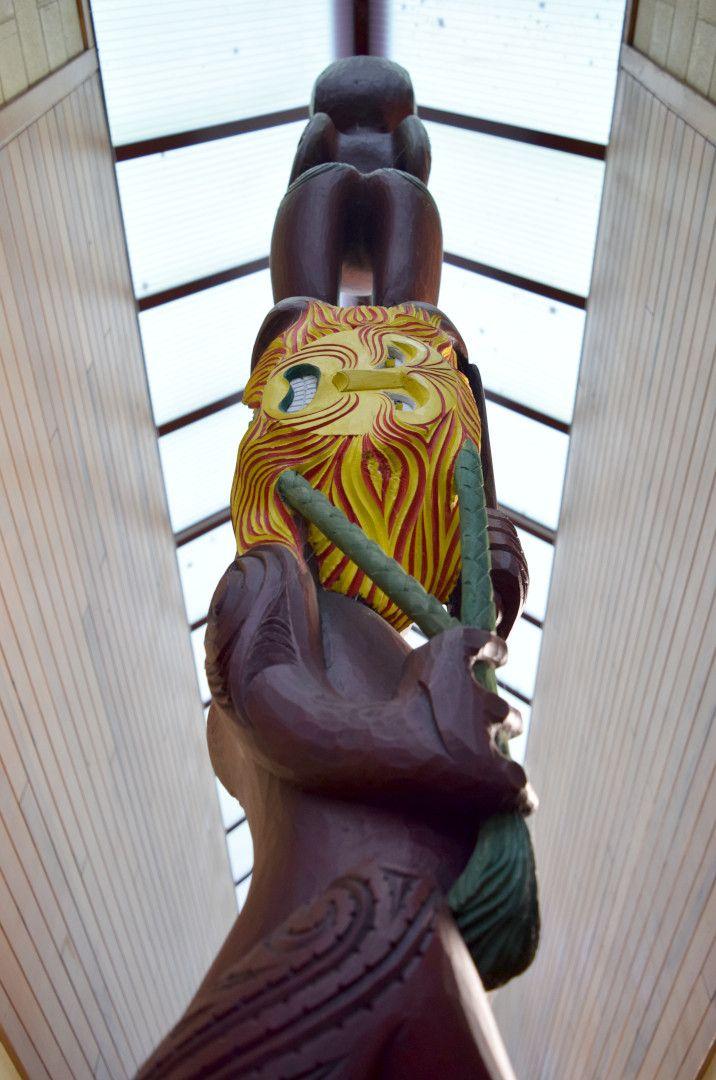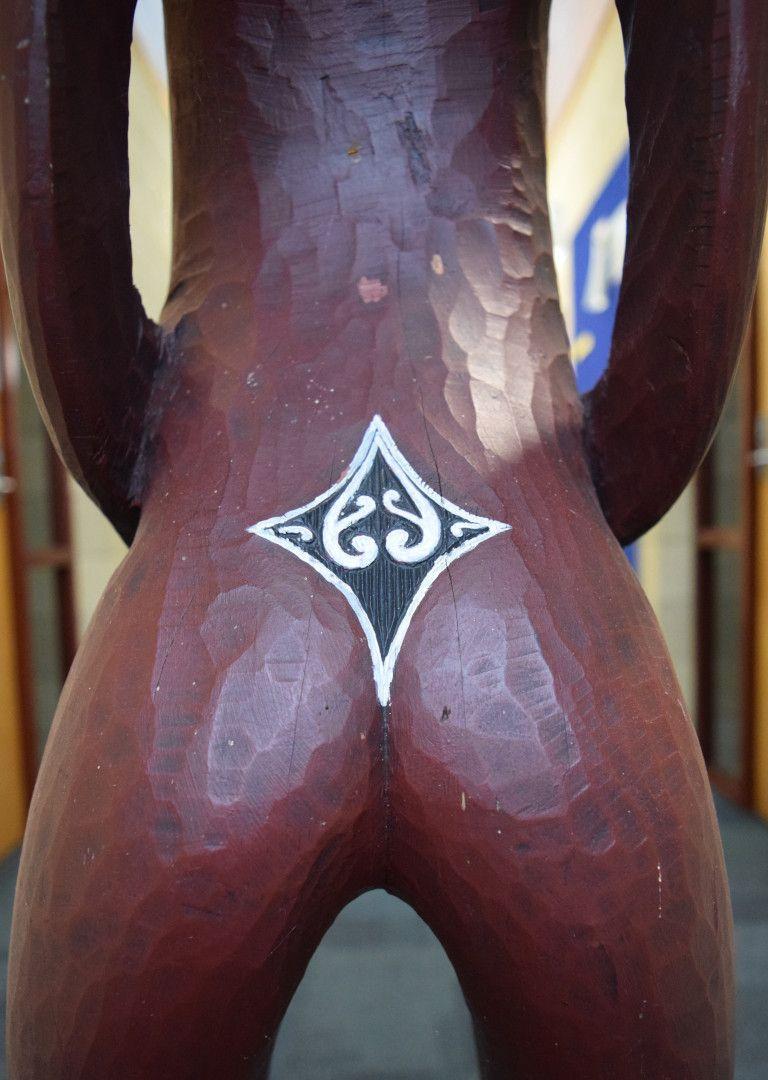Maui
Rangi Kipa
Type
- Pou
- Whakairo
Medium
- Paua shell
- Harakeke (Flax)
- Paint
- Wood
Dimensions
- Pou: H3500 x W290 x D230mm; Base Vertical: H250 x W230 x D230mm; Base Floor area: 450mm2

Rangi Kipa (Te Ātiawa, Taranaki, Ngāti Tama ki te Tauihu), ‘Maui’ (1992), University of Waikato, Kirikiriroa Hamilton
Images: Bronwyn Holloway-Smith, Public Art Heritage Aotearoa New Zealand, 2022



- DETAILS
- MAP
Description
This pou encompasses several of the myths of Maui. The work is set on a base within the corridor.
An information panel installed with the work reads:
"Ko Māui.
E rua ngā wāhi o te wāhanga tuatahi o te pou nei. Tuatahi, ko Io Matua tēnei, e pupuri ana i ngā kete mātauranga nāna i hoatu ki a Tāne. Ko te kete aronui, ko te kete tuatea, ko te kete tuauri i mauria mai ki tea o nei, hei whakatakoto tikanga, ture, whakaakoranga hoki mo ngā Whare Wānanga o mua tae noa mai ki tēnei ao.
Tuarua, ko Makea Tutara tēnei, te matua o Māui. Ka rapua ia e Māui I tētahi ao rerekē. I konei ka whakamanahia a Māui e tōna matua. Engari nā te hapa o Makea i te wā i tohia a Māui, mōhio tonu a Makea ka raru a Māui a tōna wā. Ka tau tonu te āhua o te mate ki runga i tea o nei, ka noho tonu a Hine-nui-te-pō, i tōna ao e tatari ana i a tatou.
I raro iho, ko Māui Tikitiki-ā-Tāranga, e patu ana i a Tama-te-rā. Nā konei, ka whai wā te Māori hei rapu I ngā mea whakaora tangata, whakaora tinana, whakaora ngākau. He whakaatu hoki tēnei ki ngā whakatupuranga, ahakoa ngā uauatanga ka whakatakotoria ki mua i tou nā aroaro, kia tūturu te whakapono ki tōu na kaupapa, ka taea. Koirā hoki te āhua o Māui.
Kei raro iho i a Māui, e takoto ana, ko te wahine. Tuatahi ko Tāranga tēnei, te whāea o Māui, e tangi ana. I te wā ka puta mai a Māui ki te Ao Mārama, I pohēhē a Tāranga I whanau mate roto mai a ia. Ka tapahia tōna tikitiki ka whakaraua te tamaiti nei ki roto, ka whiua ki te moana. Koinei te take e noho ana a Māui ki te tikitiki o tōna whaea I te pou nei.
Ko te whakaaturanga whakamutunga ko Hine-nui-te-pō, te kai tiaki I te hunga e rere ana ki Rarohenga. Ko tana korero ki a Tāne, māna āna tamariki e tiaki I tew ā ka hikoi rātou ki tua o te ārai. I te pou nei, e moe ana a ia. Ko tērā hoki tew ā I hāere atu a Māui ki te kōhuru i a ia. Ko tēnei tew ā i raru a Māui, ka mate. Ka tau tonu taua āhua, arā ko te mate ki tea o nei, mo ake tonu.
Māui.
The top figure is twofold in its representation. Firstly, the supreme being Io is depicted holding the three baskets of knowledge that were eventually brought to this world by Tāne. These baskets symbolise the basic principles and teachings of Whare Wānanga of the past as well as those of today.
Secondly the figure represents Makea Tutara who was Māui's father. In his efforts to discover who his father was Māui travelled to another world. It was during this time that Māui gained acceptance by his father. However because of certain omissions in the rituals of recognition conducted by Makea, Maui [sic] was not able to fulfil the ultimate challenge of overcoming death and bringing immortality to man. Maui's [sic] eventual challenge of Hine-nui-te-pō was destined to fail.
The next figure depicts Māui himself in the midst of one of his greatest adventures, the capture and slowing down the sun. This brought greater stability to the world, and provided for the development of humankind. The philosophy that any goal can be accomplished no matter what obstacles are placed in your pathway is an underlying theme of this particular episode of Māui's life.
The final figure is another double representation. Firstly, Māui's mother Tāranga is depicted in mourning. She brought Māui into the world, but thought him to be stillborn. Therefore, she cut her hair and bundled Māui up into her topknot casting him adrift on the ocean. This event is shown by Māui's position on the pou, directly above his mother on her topknot.
The final representation is of Hine-nui-te-pō, the caretaker of her children who depart for the underworld, which is her home. Her promise on moving to the underworld was to care and tend for her descendants, once they had crossed the threshold of death. She is depicted in a state of slumber, which was when Māui made his attempt to secure immortality. This was doomed to failure and Māui perished, thus humankind was to be forever mortal."
